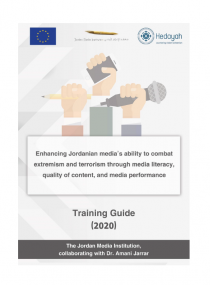
JMI - Amman
The AKEED Monitor, a project of the Jordan Media Institute (JMI), and in collaboration with the Ethical Journalism Network (EJN), has launched a dictionary and guide, directed towards those working in media outlets. The dictionary and guide include the most prominent terminology, which when used in the wrong context, forms hate speech and a violation of legal, ethical and professional standards.
A specialized study by the Jordan Media Credibility Monitor (AKEED) titled “Monitoring the Discourse of Hate in Jordanian Media Outlets” has revealed that the discourse of hate has been escalating in Jordan. This, despite the fact that it has not transformed into a phenomenon within Jordanian media, in regards to its volume, prevalence, nature, topics, sources or the entities it may target.
The monitoring of media coverage for hateful discourse within the Jordanian media aims to uncover expressions of hate, and language that promotes bias and incitement, in addition to recognizing the main features of this coverage and the values and attitudes it reflects. The goal behind this is to introduce these expressions to journalists, which in turn will have an effect on enhancing the quality of media coverage in this field.
The study analyzed the content of Jordanian media outlets to evaluate the nature and volume of hate speech, and the expressions thereof.
The dean of JMI, Ziad Rifai, said that the study helps alert reporters to the uses of terminology in sound media contexts, adding that the dictionary is a part of Jordan’s efforts in preventing the rise of hateful discourse.
EJN member, Dr. Zahera Harb, stated that this is the second edition of the guide after the first was published in Egypt, explaining that the objective was attaining ethical journalism free of hate, belittlement, and incitement against others.
The dictionary seeks to guide those working in the media field along with social media publishers, on careful use of terms and vocabulary, and to assist journalists in improving their skills when dealing with hateful discourse.
The study utilized a deliberate timeframe which was witness to various political, religious and sporting events which produced content that could be described as “hate speech” during 2016-2018, in Jordanian media.
AKEED Managing Editor Taha Darwish pointed out that the study was conducted pursuant to the logic of scholarly research, as 12951 items were monitored, and 323 of these were selected as a sample. These items had been published in nine local media outlets including daily papers, websites, and radio, along with social media platforms such as Facebook and Twitter.
The study results showed that hate speech was most prevalent on social media platforms, followed by Jordanian radio stations, then the press and finally websites.
The results also revealed that slander was the most prominent type of hateful discourse within social media, with “calls for killing and violence” in the last place. As for Jordanian radio, incitement was the most dominant and “stigmatization” was most widespread in the press, with the killing and violence calls again falling in the last place for both these outlets. Finally, in websites, stereotyping was the most prevalent and slander the least.
The results unveil that the targets of hateful discourse were as follows: In social media – sports and athletes, in radio and websites – the government and officials, and in the press – Arab and international political entities.



